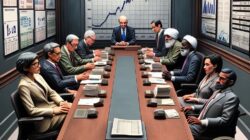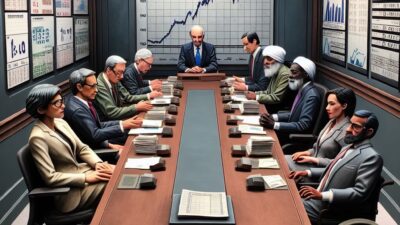Interest Rate Predictions Amid Rising Prices
Recent analyses by economists indicate that escalating price increases have effectively ruled out the possibility of an interest rate reduction by the Federal Reserve in the upcoming meeting.
Understanding the Economic Landscape
The U.S. economy has been experiencing persistent inflation, with prices rising at a pace that has drawn significant scrutiny from financial experts. The Consumer Price Index (CPI), a critical indicator of inflation, has shown an upward trend, alarming analysts and impacting both consumer and investor sentiment.
As inflation continues to rise, the Federal Reserve’s dual mandate of fostering maximum employment and ensuring price stability comes under pressure. Economists argue that maintaining low interest rates, which have facilitated borrowing and spending, may no longer be an option given the current economic climate.
Current Inflation Rates: A Cause for Concern
Recent data reveals that inflation rates are at their highest in decades, driven by multiple factors including supply chain disruptions, increased consumer demand, and rising energy prices. According to the Bureau of Labor Statistics, the CPI saw a year-over-year increase of 6.2% last month, signaling a need for monetary policy reassessment.
This surge in prices is particularly concerning as it erodes purchasing power and may compel consumers to alter their spending habits, potentially slowing down economic growth. Economists suggest that once inflation takes root, it becomes increasingly volatile, making it difficult for the Federal Reserve to navigate without drastic policy changes.
The Fed’s Dilemma: Interest Rates Versus Inflation
The Federal Reserve has historically looked to manipulate interest rates as a tool to control inflation. By raising interest rates, the Fed aims to cool off demand in the economy which, in turn, can help mitigate rising prices. However, experts highlight that the rapid pace of current inflation diminishes the likelihood of a rate cut in the short term.
“Given the data we are seeing, it’s virtually impossible for the Fed to justify a decrease in interest rates right now,” stated Dr. Elizabeth Warren, an economist at the National Bureau of Economic Research. “The focus will likely be on curbing inflation, rather than encouraging further borrowing.”
Market Reactions and Future Projections
The anticipated decisions regarding interest rates are not only influenced by economic data but also by market reactions. Stock markets have shown volatility in response to inflation reports, with investors closely monitoring Federal Reserve announcements. Any indication of a rate hike could lead to further fluctuations.
Futures markets have adjusted their expectations accordingly, shifting from a previously forecasted rate reduction to potential increases by the end of this year. Analysts have pointed out the need for clearer communication from the Fed to minimize uncertainty. Investors are particularly eager to gauge how policymakers will respond to the ongoing inflationary pressures.
Global Influences on U.S. Inflation
The interplay between domestic economic activity and global factors cannot be understated. Problems such as global supply chain disruptions, geopolitical tensions, and the ongoing effects of the COVID-19 pandemic continue to influence inflation rates. These external elements contribute to rising raw material costs and logistical challenges, which inevitably reflect on consumer prices.
Furthermore, economists suggest that trends in international markets could prompt a reevaluation of the Fed’s strategies. As inflation rates soar worldwide, coordinated responses among central banks may emerge, aiming for a more stabilized global economy.
Consumer Sentiment and Shifts in Spending Behavior
As consumers face increasing prices across various sectors—ranging from food to housing—sentiment may shift, leading to alterations in spending behavior. Economic theorists suggest that if inflation persists, consumers may tighten their budgets, prioritizing essential goods over discretionary spending.
This anticipated shift could have long-term effects on economic recovery, as businesses may experience decreased sales revenues. Lower consumer spending could exacerbate a slowdown in economic growth, thereby presenting a complex challenge for policymakers tasked with navigating these turbulent times.
Conclusion: The Path Forward for the Federal Reserve
In light of persistent inflation and its implications, the Federal Reserve faces a multifaceted challenge. The likelihood of interest rate reductions has diminished, and the focus appears to be shifting toward controlling inflation rather than stimulating growth.
Economists stress the importance of maintaining a balanced approach—addressing inflation without stifling the economic recovery. As the situation evolves, close attention will be paid to upcoming Fed meetings, with expectations centered around decisive actions aimed at steering the economy back to a more stable equilibrium. The coming weeks may reveal how aggressively the Fed will act to tackle the inflationary pressures that are impacting consumers and the broader economy.












